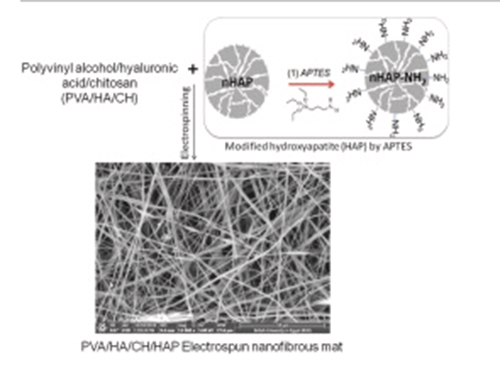Copyright © 2022 Foshan MBRT Nanofiberlabs Technology Co., Ltd All rights reserved.Site Map
3D-scaffolds composed of polyvinyl alcohol-hyaluronan (PVA/HA) nanofiber mats were fabricated by electrospinner. Spinning conditions of PVA/HA were optimized for obtaining uniform and smooth nanofibers (NFs). Resultant NFs were investigated by SEM, FT-IR and mechanical tensile. Chitosan was incorporated into NFs mats during spinning for reducing bleeding, microbial growth of wound bed, and enhancing viability/proliferation of cells in damaged tissues. Hydroxyapatite (HAP) after silanization using (3-aminopropyl)triethoxysilane (APTES) was also incorporated into scaffolds due to its similar chemical composition with mineral composition of bone, which stimulates interactions between bone tissue and biomaterial resulting in a prominent interface after implantation. NFs with different compositions were bio-evaluated in vitro using antimicrobial activity, hemolysis(%), cytotoxicity, and cell adhesion tests. Results revealed that, addition of HAP into PVA/HA mats improved significantly their mechanical/thermal stability and relatively hindered swelling index, compared to mats without HAP. However, addition of chitosan enhanced swelling index and antimicrobial activity of mats. All tested mats with different compositions showed high cell-viability, regardless incubation time or concentration of tested nanofibers. In-vitro cell adhesion results indicated that, WI38 cells adhered and proliferated adequately with nanofibers containing HAP. Such findings support the ability for using PVA/HA/CH/HAP NFs as biomaterials for bone tissue regeneration soon.

Published: 2021
Journal :J DRUG DELIV SCI TEC
Impact Factor:2.933
Paper link:https://www.sciencedirect.com/science/article/abs/pii/S1773224721000976